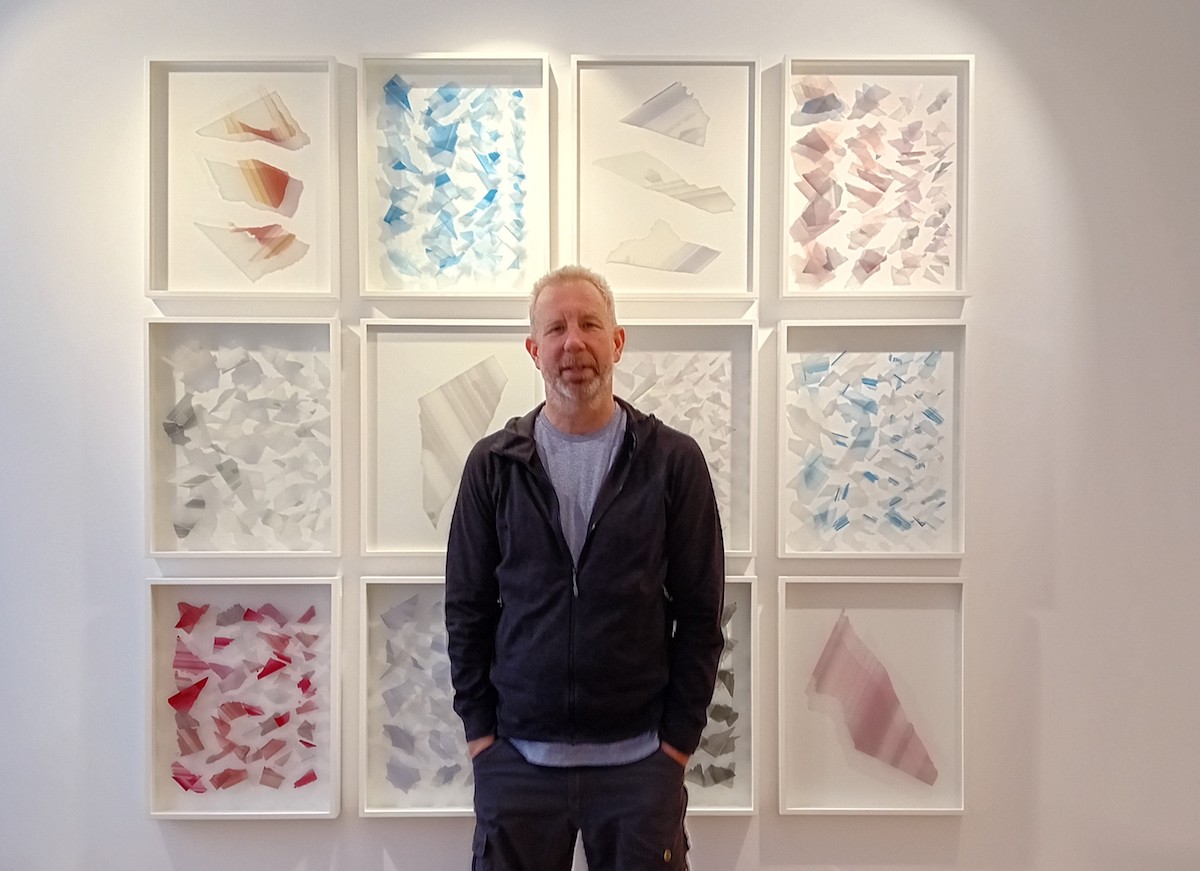There are plenty of impressive shows timed to coincide with Frieze[i]. Still, I haven’t seen Eric Butcher featured in highlights lists, even though ‘Shadow Archive’, his solo exhibition at the excellently appointed GPS Gallery, is arguably the most original currently on view. That said, my assessment does seem to be gaining traction: Butcher is the recent winner of both the Evelyn Williams Drawing Award (which leads to a solo show at Hastings Contemporary in 2027) and the Royal West of England Academy Award for the best work in its Annual Open Exhibition in Bristol.
I wrote about Butcher at some length six years ago [ii], when he had already spent twenty years creating process-driven art with exacting attention to his materials and their method of application, abstract and minimalist in aesthetic yet rich in background content. I characterised his most frequent procedure as ‘stripping paint on an aluminium plane into monochrome striations with aluminium blades’. Still, I concluded that, while the surface allure of the results was evident, ‘the richness of his art – its trans-aesthetic content – stems from both the breadth and rigour of his attention to material and processes, and the way those methodologies chime with the ways we live and experience time. We may not be conscious of all that, but I suspect it is those underlying sources of richness which make Butcher’s work convincing. ‘It isn’t what it looks like,’ in Sol LeWitt’s words, ‘but what it is that is of basic importance’ [iii].
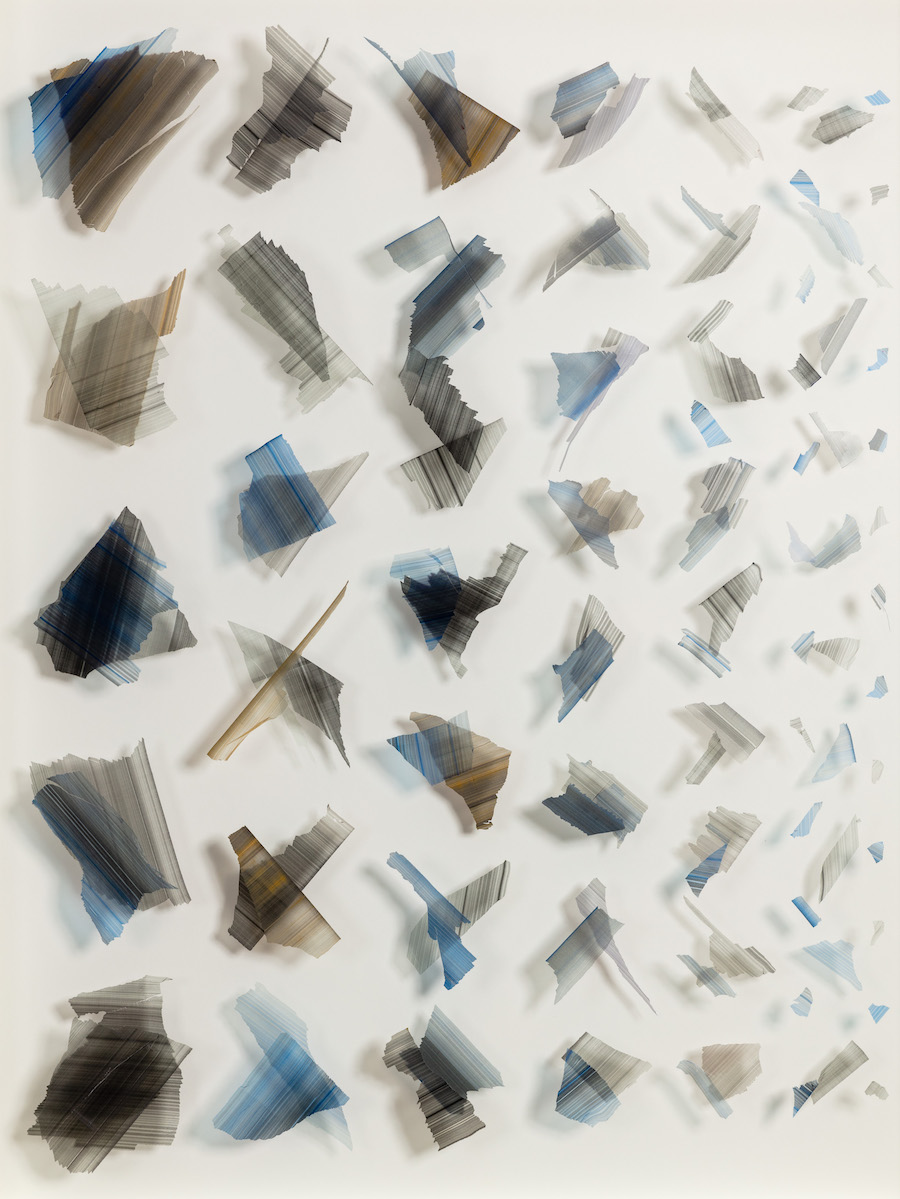
Recycled Paint Fragments: Acrylic, Graphite + Acrylic Gel on Glass, 109 x 86 cm, 2024
Shortly afterwards, Butcher began his ‘Endgame’ project, declaring that he would use what was already in his studio, but bring in nothing new. Once everything had been used up, his art practice would be at an end. That arose from the experience of the COVID-19 lockdown. In Butcher’s words: ‘Confronted by the devastating impact of human behaviour on the planet, my former practice seemed deeply problematic and indulgent. What was it that my work consisted of but taking precious resources and turning them into useless objects?’ [iv] And so he committed to using only those materials already available in the studio; repurposing and recycling what he already has without consuming more. He will draw out his current resources for as long as possible, being as frugal as he can, and once he has run out of materials, he will stop making art. The environmentalist parallels of that are evident.
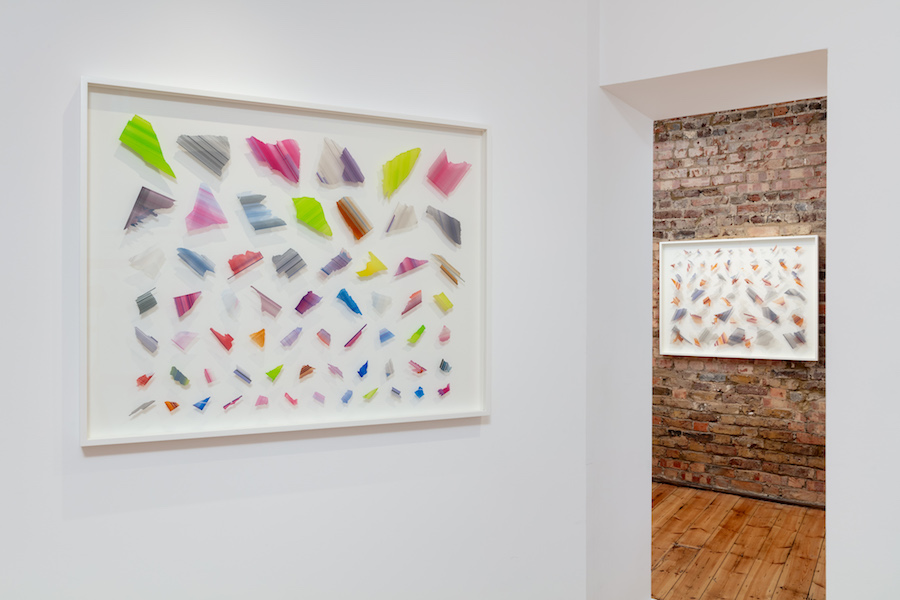
You can view the results of the Endgame project at GPS Gallery, Soho (until 18 October, with late opening on Saturdays until 8 pm). The work is based on three strategies consistent with Butcher’s declaration. First, he deconstructs the finished works he had stored in the studio in 2020, cutting away fragments of paint – butchering them, I suppose- to form new arrangements. Second, he makes new work from the art materials he had in stock pre-pandemic – he tells me they are not dissimilar from his historic productions and proceeds to deconstruct them in the same way as the old work.
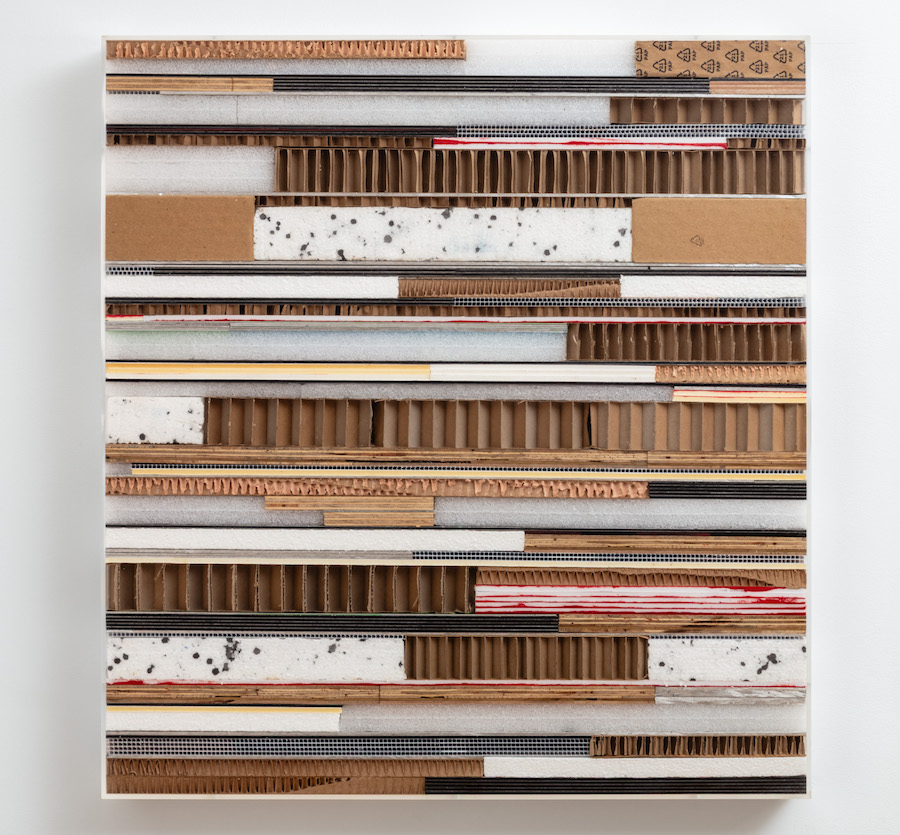
And, third, he makes use of any ostensibly non-art materials in the studio, for example, packaging in which materials arrived, to create new work. Evidently, those are three finite sources, though Butcher tells me that he expects to squeeze several years of further work out of them: the endgame could be a pretty long one. The only new materials you will see in ‘Shadow Archive’ are those used to present the work, rather than constituting it: the wood and glass that hold and frame it in exemplary fashion.
You could say, then, that Butcher’s artistic practice now feeds on itself. As he has explained[v], he pulls his previous works apart ‘both intellectually and physically, peeling the skins of paint from their supports and categorising them according to a basic taxonomy, subjecting my entire practice to a sort of forensic examination’. The resulting skins, fragments, and traces of paint are sandwiched between sheets of glass, much like specimens. The business of recycling paint skins is painstaking. Butcher fixes them to a sheet of transparent adhesive, and then he cuts around each one, meticulously, with a scalpel. He can tell where they are likely to break – along the lines of striations – but cannot fully control the process.
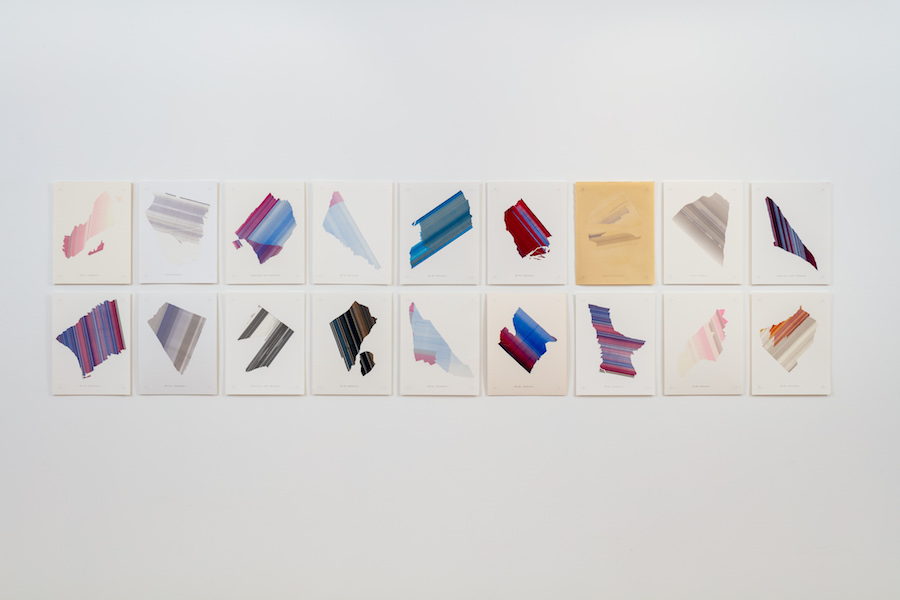
Jonathan Watkins, in his essay on the Endgame project[vi], picks up on Butcher’s background as a lapsed Catholic, noting that ‘his archival method, whereby peeled traces of his own paint strokes are isolated and sealed within a frame, has clear religious connotations. He likes the idea of relics, the idea of preserving something, and ‘the vaguely visceral quality of the peelings, like skin, only serves to reinforce our understanding of his new works as reliquaries.’ So the new context for the work adds to the richness I identified in 2019. ‘Shadow Archive’ allows for spiritual, environmentalist, and existentialist interpretations (the echo of Samuel Beckett’s play in the project title is no coincidence), as well as engaging with the history of art.
Yet there is also the matter of how the productions within that resonant overall setting operate as individual artworks. It turns out that the constraints have yielded a distinctive aesthetic, resulting in considerable beauty. That operates like the well-established approach of process-based abstraction, which produces only partially controllable, yet aesthetically compelling, results – one might think, internationally, of Gerhard Richter, Bernard Frize, and Katherine Grosse; or within Britain, of Alexis Harding, Michael Stubbs, and Callum Innes. The difference being that Butcher’s process isn’t one of composition, but of de-composition – despite which its tone feels very different, far gentler, from the auto-destructive work of, say, Jean Tinguely, Gustav Metzger and John Latham.
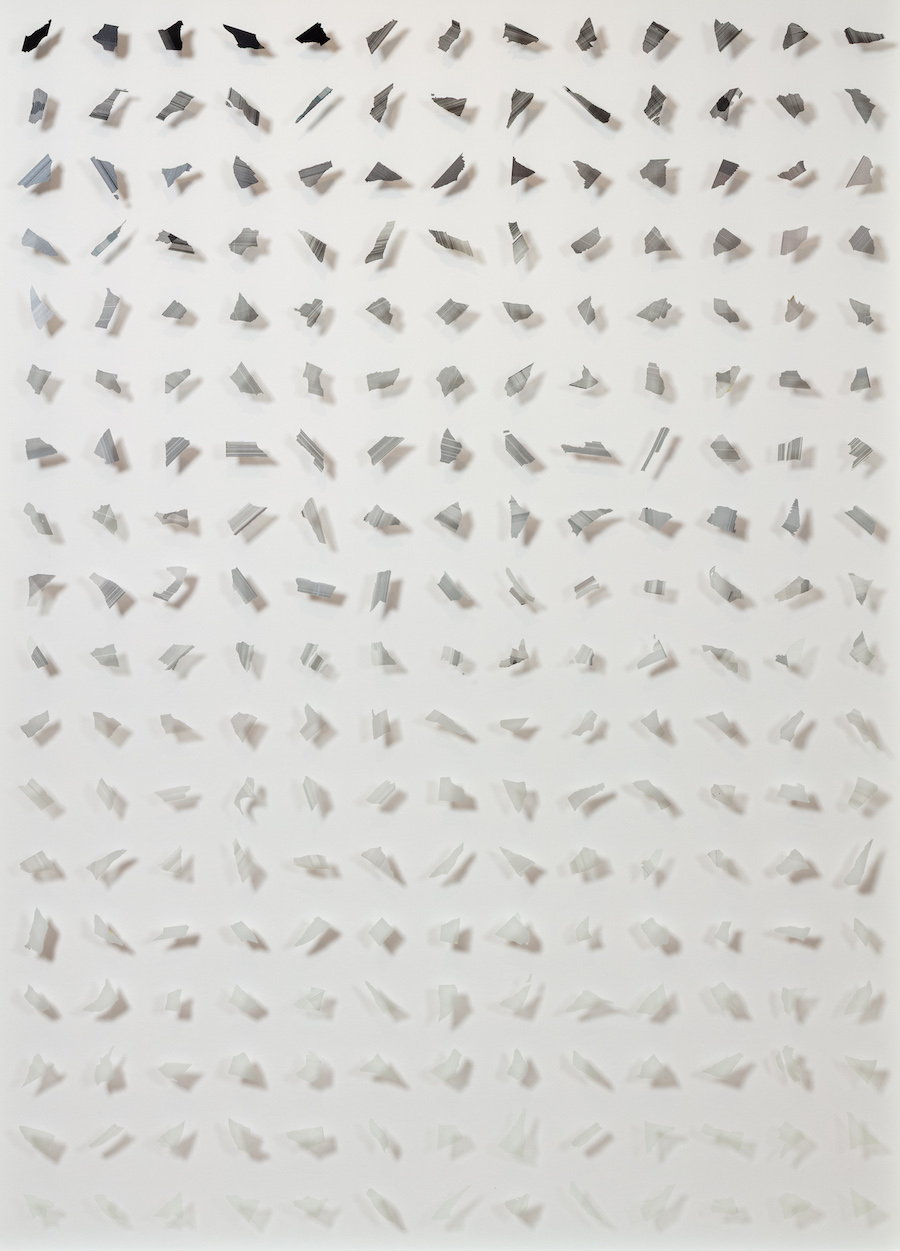
The paint fragments themselves – sometimes seen in isolation, more often in concert- prove to be alluring shapes, heightened by their placement on glass, often with the fragments layered by the use of two or three panes within the same work. That brings depth and shadow into play – the show is not just a ‘shadow archive’ of Butcher’s previous practice, transformed, but also an archive of shadows. The arrangement of T/R 1080 makes the most of that, as both the fragments and their consequent shadows are gradated to start darkest at the top of the frame and end lightest at the bottom, almost vanishing into their background. That generates a shimmering transition that might be related to Bridget Riley’s work of the 1960s.
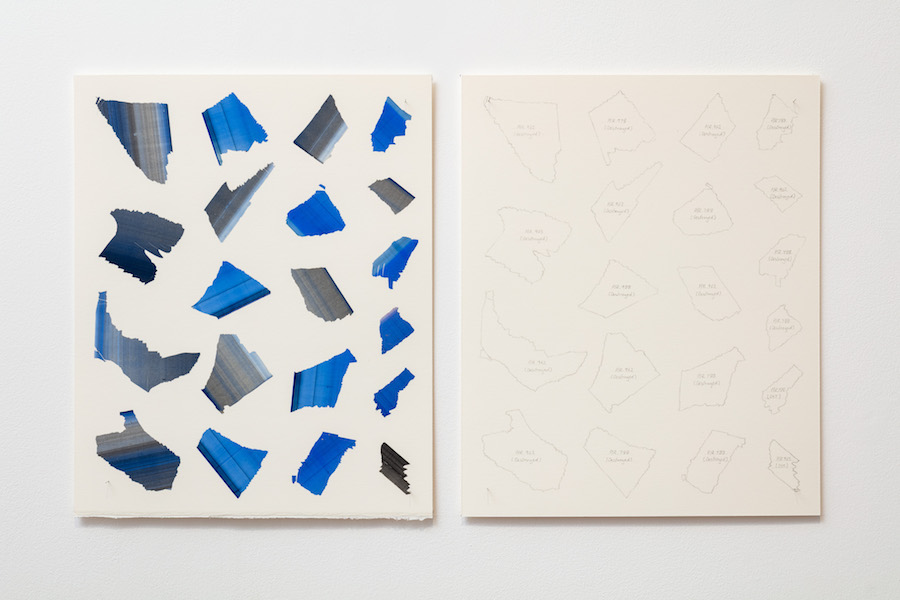
The paint shapes are strictly abstract, yet their contexts suggest possible readings. Some, such as G/R 1083, are labelled with their origins, suggesting museum categorisation. Specimen pins attach the fragments to the support of G/R.1086-1103, encouraging an interpretation as an etymological display. Other presentations evoke archaeological fragments, consistent with searching for the lifestyles implied by the fragmentary evidence of the everyday past. Those paint fragments are from the primary, frontal aspect of the deconstructed work.
[i] A little arbitrarily, I could mention institutional shows (Peter Doig at the Serpentine Gallery, Ryan Gander at Camden Art Centre, Hatoum / Giacometti at the Barbican, Wayne Thiebaud at the Courtauld,), major commercial galleries (El Anatsui at Goodman and October Galleries, Victor Man at David Zwirner, Kaari Upson at Sprueth Magers, Christopher Wool at Gagosian), quality shows at smaller commercial galleries (Bex Massey at Seventeen, Danielle Fretwell at Alice Amati, The Starns at HackelBury Fine Art, David Hepher at Flowers) or alternative spaces (Claire Fontaine at Mimosa House, Christopher Williams at The Perimeter, Hoi Polloi at the Brown Collection, Matthew Collings at Handel Street Projects)…
[ii] Paul Carey-Kent: ‘Richness in Rightness’ in Eric Butcher: Time Trial, Galerie Robert Drees, Hannover, and
Patrick Heide Gallery, London 2019
[iii] Sol LeWitt: Interview in BOMB Magazine, 2003
[iv] Statement on the artist’s website
[v] From the artist’s websit
[vi] Jonathan Watkins: ‘The artist who wants to stop making art’, 2025

